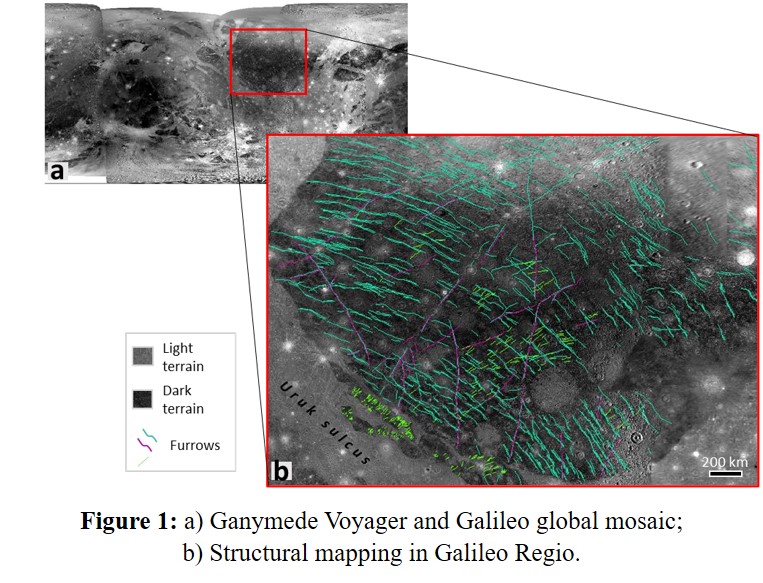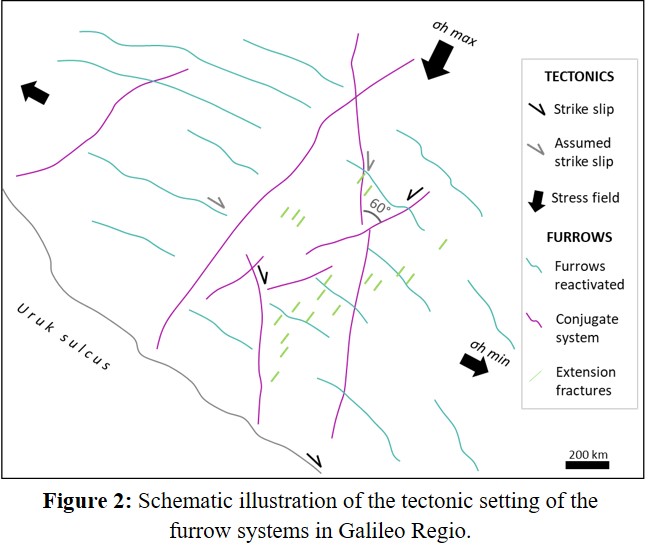Dark Terrain shortening and strike-slip in Galileo Regio, Ganymede.
- 1Istituto Nazionale di Astrofisica, Padova, Italy (costanza.rossi@inaf.it)
- 2Department of Geosciences, University of Padova, Italy
- 3CISAS, University of Padova, Italy
- 4Department of Physics and Astronomy, University of Padova, Italy
Ganymede’s dark terrain represents the older geologic unit of the satellite, subsequently crosscut by swaths belonging to the younger light terrain. Compared to the light terrain, the dark terrain shows low albedo, higher crater density and morphotectonic structures called furrows. These structures are radial or circumferential fragments of troughs bounded by high albedo rims and a low albedo floor, generally thought being the remnants of a multi-ring impact basin similar to the Valhalla or Asgard basins on Callisto [1, 2]. In particular, in Galileo Regio and Marius Regio, the furrow systems show a concentric pattern centered at around 20° S 180° W, which is the assumed location of the crater formed by an impactor of 50-150 km in radius [3, 4]. Many furrows have been preserved until the present day in their pristine form, while some of them have acted as zones of weakness re-used by subsequent tectonic deformation. For this reason, they show a more complex morphology and are likely considered as precursors of light grooved terrain formation.
In this contribution, we perform a structural mapping at the regional scale of the furrows in Galileo Regio, identifying their hierarchy and tectonic setting originated by the regional scale kinematics. Our mapping reveals that transpression, already recognized in the adjacent Uruk Sulcus area [5], affects the dark terrain of Galileo Regio, too. We mapped the structures in Galileo Regio (Fig. 1) by considering their spatial distribution and crosscutting relationships. In addition, we mapped the local-scale fractures that have tectonically modified remnants of furrows by leaving a deformation zone with higher albedo with respect to the surrounding dark material. These fractures show geometries and features associated with the Riedel shear, and synthetic and antithetic structures that form in strike-slip regimes [6]. The NE-SW and NW-SE trending structures that crosscut the concentric furrow systems occur from Uruk Sulcus to approximately 60° N and have been recognized as conjugate (Fig. 2). Hence, the setting of the mapped furrows and their associated structures allows identifying the (paleo)stress field that has affected this dark terrain. We infer that Galileo Regio has been characterized by regional kinematics consistent with the right-lateral transpression that has affected Uruk Sulcus. It is possible to recognize a ≈ NE-SW trending maximum horizontal stress (σh max) responsible for a shortening associated with strike-slip in the area that extends from 180°-120° W to 0°-60° N. Therefore, we can assume that the dark terrain has been deformed by the same tectonic processes that have formed the light grooved terrain of Uruk Sulcus.
This work confirms the key role that transpression has played in the leading hemisphere of Ganymede and the reactivation (and possibly the inversion) of the furrows in Galileo Regio, which have followed a deformation history beginning from an impact origin to a tectonic remodeling. Further geo-statistical analysis will be performed to support this reconstruction. Obtained results from this study will be used for the scientific preparation of dedicated high-resolution observations that will be taken with the JANUS instrument [7] onboard JUICE mission [8].


Acknowledgements:
The activity has been realized under the ASI-INAF contract 2018-25-HH.0.
References:
[1] McKinnon, W.B., Melosh, H.J., 1980. Evolution of planetary lithospheres: evidence from multiringed structures on Ganymede and Callisto. Icarus 44 (2), 454–471. https://doi.org/10.1016/0019-1035(80)90037-8.
[2] Prockter, L. M., Figueredo, P. H., Pappalardo, R. T., Head, J. W., & Collins, G. C. (2000). Geology and mapping of dark terrain on Ganymede and implications for grooved terrain formation. Journal of Geophysical Research: Planets, 105(E9), 22519-22540.
[3] Prockter, L.M., Collins, G.C., Murchie, S.L., Schenk, P.M., Pappalardo, R.T., 2002. Ganymede furrow systems as strain markers: implications for evolution and resurfacing processes. In: 33rd Lunar and Planetary Science Conference, Abstract #1272. Lunar and Planetary Institute, Houston.
[4] Hirata, N., Suetsugu, R., & Ohtsuki, K. (2020). A global system of furrows on Ganymede indicative of their creation in a single impact event. Icarus, 352, 113941.
[5] Rossi, C., Cianfarra, P., Salvini, F., Mitri, G., Massé, M., 2018. Evidence of transpressional tectonics on the Uruk Sulcus region, Ganymede. Tectonophysics 749, 72–87. https://doi.org/10.1016/j.tecto.2018.10.026
[6] Fossen, H. (2010). Structural geology. Cambridge, UK: Cambridge University Press.
[7] Palumbo, P. et al. 2014. JANUS: The Visible Camera Onboard the ESA JUICE Mission to the Jovian System. 45th LPSC Meeting. Abstract #2094.
[8] Grasset, O., Dougherty, M. K., Coustenis, A., Bunce, E. J., Erd, C., Titov, D., et al. (2013). JUpiter ICy moons Explorer (JUICE): An ESA mission to orbit Ganymede and to characterise the Jupiter system. Planetary and Space Science, 78, 1–21.
How to cite: Rossi, C., Lucchetti, A., Massironi, M., Pozzobon, R., Penasa, L., Munaretto, G., Pajola, M., and Cremonese, G.: Dark Terrain shortening and strike-slip in Galileo Regio, Ganymede., European Planetary Science Congress 2021, online, 13–24 Sep 2021, EPSC2021-567, https://doi.org/10.5194/epsc2021-567, 2021.

